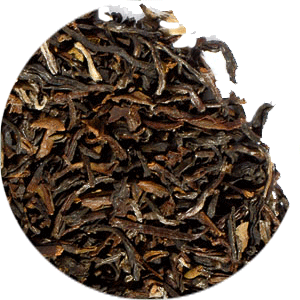Message

Soom 1st Flush
Country of Origin: India
Region: Darjeeling
Soom 1st Flush
1st Flush occurs in Darjeeling from March through to mid April, during this period the tea bushes have once again begun ‘flushing’ (read growing) after the winter dormancy period. Vigorous flushing occurs because the daytime temperature has risen 5 to 7 degrees Celsius (from 10/12 C to 20 Celsius); the hours of daylight have increased (the vernal equinox has passed); and despite the fact that the weather is dry there is excellent moisture retention in the soil from the winter rains. All these factors in the rarefied mountain air help produce this stunning tea. The plucking fields of Soom are about 5200 feet above sea level and the terrain is very severe with some of the slopes approaching 45 degrees. The slopes are so steep that the estate still carries the green leaf to the factory by mountain pony. Many of the bushes are over 130 years old but produce remarkable tea; in fact it is not uncommon for some 1st Flush teas to be rushed to Germany in a race similar to the Beaujolais Run.
There are several theories about the origin of the name of the estate. ‘Soom’ in Lepcha Language (local dialect) means ‘Three’ or ‘Triangular’ Interestingly the estate is bounded by three streams and is somewhat triangular in shape. Another school of thought is Soom also means ‘holy abode’ and as Soom has a holy deity who is worshipped, it is possible the name originated from here. The factory burned to the ground in 1995 and was out of production for 1 1/2 years. The new factory has all modern equipment, which now produces some of Darjeeling’s best teas. Top tea estates perform a social function and Soom is exemplary in this regard. The estate not only employs 700 people, but provides housing, food and medical needs for the families resulting in about 2000 people living on the estate in full view of the Himalayan Mountains.
There are 3 main times of year for producing good quality Darjeelings:
1st flush - Springtime harvested teas from late Feb. to mid April. The young leaves yield a light tea with generally intense muscatel with ‘point’. A gentle afternoon tea.
2nd flush - Harvested in June, these teas are more fully developed. The liquor is bright and the taste full and round excellent muscatel. A superb afternoon tea that is especially good with scones and raspberry conserve.
Autumnal - Not always available depending upon the weather, they are typified by a round taste and coppery liquor. Excellent as a breakfast tea with milk.
Brewing Tips - Hot Tea: This tea is best enjoyed using 2-3 heaping teaspoons for a 6 cup teapot. Allow the tea to steep for 3-5 minutes, remove the leaves and pour. We do not recommend adding milk or sugar since this can mask some of the intrigue and subtle nuances of this vintage tea.
Brewing Tips - Cold Tea: Place 6 teaspoons of tea into a teapot or heat resistant pitcher. Pour 1 1/4 cups of freshly boiled water over the tea. Steep for 5 minutes. Quarter fill a serving pitcher with cold water. Pour the tea into your serving pitcher straining the leaves. Add ice and top-up the pitcher with cold water. Garnish and sweeten to taste. [A rule of thumb when preparing fresh brewed iced tea is to double the strength of hot tea since it will be poured over ice and diluted with cold water].
